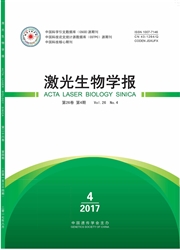

 中文摘要:
中文摘要:
生物医学光子学与非线性光纤光学在早期是两门不相干的领域,但是自从基于光纤的连续光谱被发现以来,由于其具有的宽光谱可以实现多种荧光团的同时最优激发,可获取现有钛蓝宝石激光器不可产生的波长,生物医学光子学就开始尝试利用光纤连续光谱技术。但是由于超连续光谱的低相干性、高噪声、不稳定性等原因,生物医学光子学难以广泛的利用这一技术。如何基于现有的100-fs钛蓝宝石激光器产生宽带且可线性压缩的连续光谱仍旧是非线性光纤光学的重要挑战。为了产生可线性压缩的连续光谱,就必须研究光纤和激光脉冲参数对光纤连续光谱产生的影响,研究如何增强可压缩的非线性效应并抑制导致连续光谱不可压缩的非线性效应,以在光纤中产生宽带且可压缩的连续光谱。超连续谱的特性将使其在生物医学光子学,尤其是在成像方面发挥巨大的作用,因此具有重要的学术意义和实际应用价值。
 英文摘要:
英文摘要:
Biophotonics and nonlinear fiber optics have traditionally been two independent fields.Since the discovery of fiber-based supercontinuum generation,biophotonics applications have experienced a large impact from nonlinear fiber optics,primarily because of the access to a wide range of wavelengths and a uniform spatial profile afforded by fiber su-percontinuum.However,biophotonics applications have difficulty in employing supercontinuum generation for reasons such as poor coherence,high noise and insufficient controllability.How to generate a linearly compressed continuum with broadband spectra based on 100-fs Ti:Sapphire oscillators is still a challenge in nonlinear fiber optics.In order to generate a linearly compressed continuum,we must investigate the influences of the fiber and laser pulse parameters on fiber continuum generation.Then we can know how to enhance compressible nonlinear effects while suppress incompress- ible nonlinear effects for linear compressible continuum generation in optical fiber. The characteristics of supercontinuum will play a great role in biomedical photonics, especially in microscopy.
 同期刊论文项目
同期刊论文项目
 同项目期刊论文
同项目期刊论文
 Characterization of collagen fibers by means of texture analysis of SHG images using orientation-dep
Characterization of collagen fibers by means of texture analysis of SHG images using orientation-dep Numerical analysis of coupling characteristics of tunable photonic crystal fiber coupler for nonline
Numerical analysis of coupling characteristics of tunable photonic crystal fiber coupler for nonline Simultaneous characterization of pancreatic stellate cells and other pancreatic components within th
Simultaneous characterization of pancreatic stellate cells and other pancreatic components within th Resolution and contrast enhancement of second harmonic generation microscopy with a circularly polar
Resolution and contrast enhancement of second harmonic generation microscopy with a circularly polar Nonlinear optical microscopy for immunoimaging: a custom optimized system of high-speed, large-area,
Nonlinear optical microscopy for immunoimaging: a custom optimized system of high-speed, large-area, Enhanced self-phase modulation enables a 700-900 nm linear compressible continuum for multicolor two
Enhanced self-phase modulation enables a 700-900 nm linear compressible continuum for multicolor two 期刊信息
期刊信息
